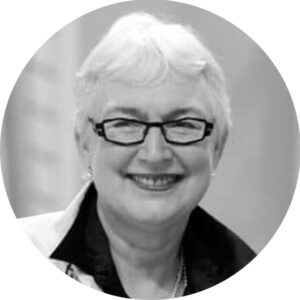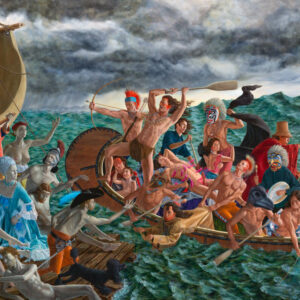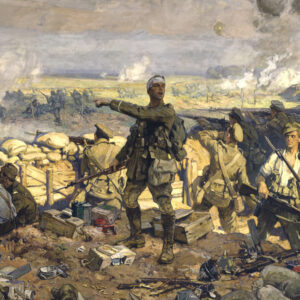-
Cann, Elizabeth (Canadian, 1901–1976)
Born in Yarmouth, Nova Scotia, Cann trained professionally in Montreal, Philadelphia, New York, and parts of Europe, including at the short-lived Harvey-Procter School of Painting in Newlyn, Cornwall, England, and the Académie Julian in Paris, among other art schools. Returning to Yarmouth in 1936, Cann became a member of the Nova Scotia Society of Artists, specializing in portraiture. See artwork by this artist.
-
Challener, Frederick (British/Canadian, 1869–1959)
A student of George Agnew Reid, Frederick (Fred) Sproston Challener began his career as a lithographer and painter. After travelling in Europe and the Middle East, he began to work as a muralist, working initially through the Toronto Society of Mural Decorators and the Toronto Guild of Civic Art, and collaborating with artists including C.W. Jefferys. He later received numerous theatre commissions, including for the murals decorating the interior of Toronto’s Royal Alexandra Theatre. See artwork by this artist.
-
Clark, Paraskeva (Russian/Canadian, 1898–1986)
An outspoken painter who advocated for the social role of the artist and Canadian and Russian cultural ties, Clark arrived in Toronto via Paris in 1931. Her subjects were still lifes, self-portraits, landscapes, and memories of her Russian home. Clark supported fundraising efforts for Spanish refugees during the Spanish Civil War and for the Canadian Aid to Russia Fund in 1942. See artwork by this artist.
-
Clemesha, Frederick (Canadian, 1876–1958)
Born in Lancashire, England, Clemesha set up an architectural practice in Regina, Saskatchewan, in the early 1900s and during the First World War served as a lieutenant in the 46th Infantry Battalion of the Canadian Expeditionary Force. Resuming work as an architect after the war, he was the runner-up in the competition organized by Canadian Battlefields Memorial Commission to design First World War memorials in France and Belgium. His design, known as The Brooding Soldier, was unveiled in July 1923 at St. Julien, Belgium, marking the site of the first large scale gas attack during the Second Battle of Ypres in 1915. See artwork by this artist.
-
Cloutier, Albert (Canadian, 1902–1965)
A largely self-taught artist known for his Canadian landscapes, Cloutier was part of the Montreal-based “Oxford Group” of artists, named for the tavern they frequented, and regularly painted with contemporaries A.Y. Jackson and Edwin Holgate. During the Second World War, Cloutier was Art Director for the Wartime Information Board in 1941, and from 1943 to 1946 he was the only francophone official Canadian war artist, serving with the Royal Canadian Air Force. See artwork by this artist.
-
Collier, David (b.1963)
Born in Windsor, Ontario, David Collier is a Hamilton-based artist, cartoonist, and reservist widely known for his comic essays for the Globe and Mail, National Post, and other publications. During his first stint in the Canadian Armed Forces (1987–90), he contributed comics to the army newspapers the Cornwallis Ensign, CFB Chilliwack Mountaineer, and CFB Valcartier Adsum. In 2005 Collier became an official war artist with the Canadian Forces Artists Program. In 2014, the Art Gallery of Ontario commissioned him to create a work that became the print publication Colville Comics and gallery installations at the AGO and National Gallery of Canada. See artwork by this artist.
-
Collins, John (Canadian, 1917–2007)
Having trained in Fine Art at Sir George Williams University (now Concordia University), Collins went on to become a well-respected cartoonist for the Montreal Gazette for over forty years. He is known for creating “Uno Who,” a recurring character representing the Canadian taxpayer that first appeared in his cartoons in 1940. During the Second World War, Collins created popular cartoons on the war effort, several of which were reprinted in the New York Times. See artwork by this artist.
-
Colville, Alex (Canadian, 1920–2013)
A painter, muralist, draftsman, and engraver whose highly representational images verge on the surreal. Colville’s paintings typically depict everyday scenes of rural Canadian life imbued with an uneasy quality. Since his process was meticulous—the paint applied dot by dot—he produced only three or four paintings or serigraphs per year. See artwork by this artist.
-
Comfort, Charles (Canadian, 1900–1994)
A major figure in twentieth-century Canadian art, who began his career as a commercial artist. He took up painting in his twenties, and became a member of the Canadian Society of Painters in Water Colour and the Canadian Group of Painters. Comfort served as director of the National Gallery of Canada, Ottawa, from 1959 to 1965. See artwork by this artist.
-
Connolly, Don (Canadian, b.1931)
Born in Kingston, Ontario, Connolly enlisted with the Royal Canadian Air Force in 1950, where he logged over 4,000 flying hours as a navigator. After leaving the air force, he worked as a professional artist for more than two decades and played an important role in the formation of the Canadian Aviation Artists Association. See artwork by this artist.
-
Coughlin, William Garnet “Bing” (Canadian, 1905–1991)
Born in Ottawa, Coughlin worked as a cartoonist during the Second World War while serving as a sergeant with the Canadian Army’s 4th Princess Louise Dragoon Guards. His wartime cartoons featuring “Herbie” remain notable representations of the shared everyday experiences of Canadian soldiers. See artwork by this artist.
-
Cowley-Brown, Patrick (Canadian, 1918–2007)
In 1941, Cowley-Brown enlisted with the Royal Canadian Air Force, training as a wireless air gunner. After becoming ill overseas, he was stationed at Rockcliffe air base in Ottawa from 1942 to 1944, producing artwork among other duties and forming relationships with artists Edwin Holgate and Charles Goldhamer. Cowley-Brown became an official war artist in May 1944, and his subjects include servicemen, military equipment, and scenes of military life on Canada’s west coast. See artwork by this artist.
-
Cullen, Maurice (Canadian, 1866–1934)
Like many Canadian painters of his generation, Maurice Cullen received his early art education in Montreal, then moved to Paris to continue his studies at the Académie Julian, the Académie Colarossi, and the École des beaux-arts. He was influenced by Impressionism, and his landscapes, in turn, influenced a younger generation of Canadian painters, including the Group of Seven. His winter landscapes and snowy urban scenes are considered his most impressive achievement. See artwork by this artist.
-
Curnoe, Greg (Canadian, 1936–1992)
A central figure in London regionalism from the 1960s to the early 1990s, Curnoe was a painter, printmaker, and graphic artist who found inspiration in his life and his Southwestern Ontario surroundings. His wide-ranging art interests included Surrealism, Dada, Cubism, and the work of many individual artists, both historical and contemporary. See artwork by this artist.
-
 About the Author
About the Author
Laura Brandon was the Historian, Art and War, at the Canadian War Museum from 1992 until 2015.
-
 More Online Art Books
More Online Art Books
Read online or download the ACI’s incredible library of art books for free in French and English.
Learn More -
 Read from Beginning
Read from Beginning
Throughout history, there have always been conflicts between different peoples and rival countries.
Learn More
